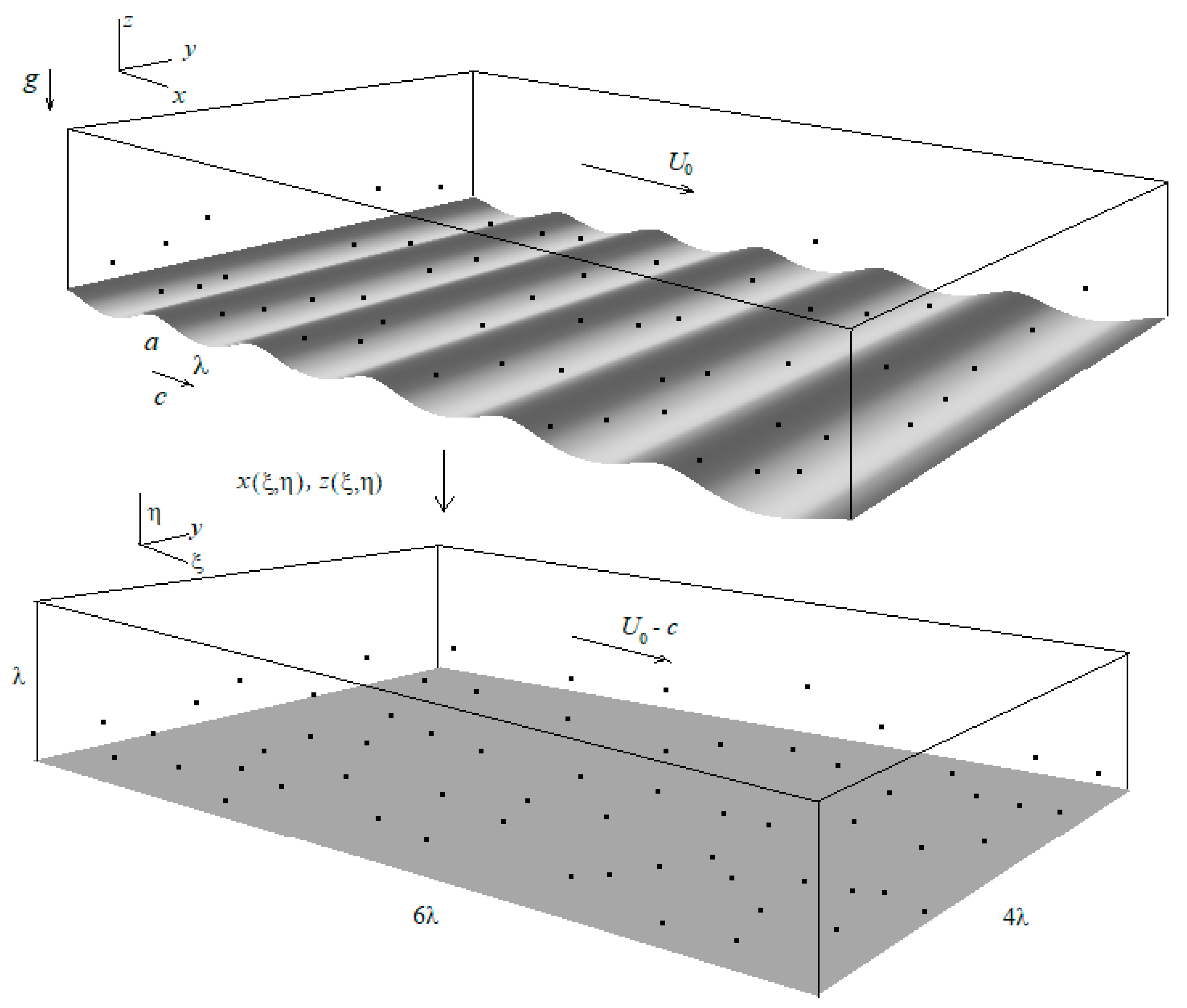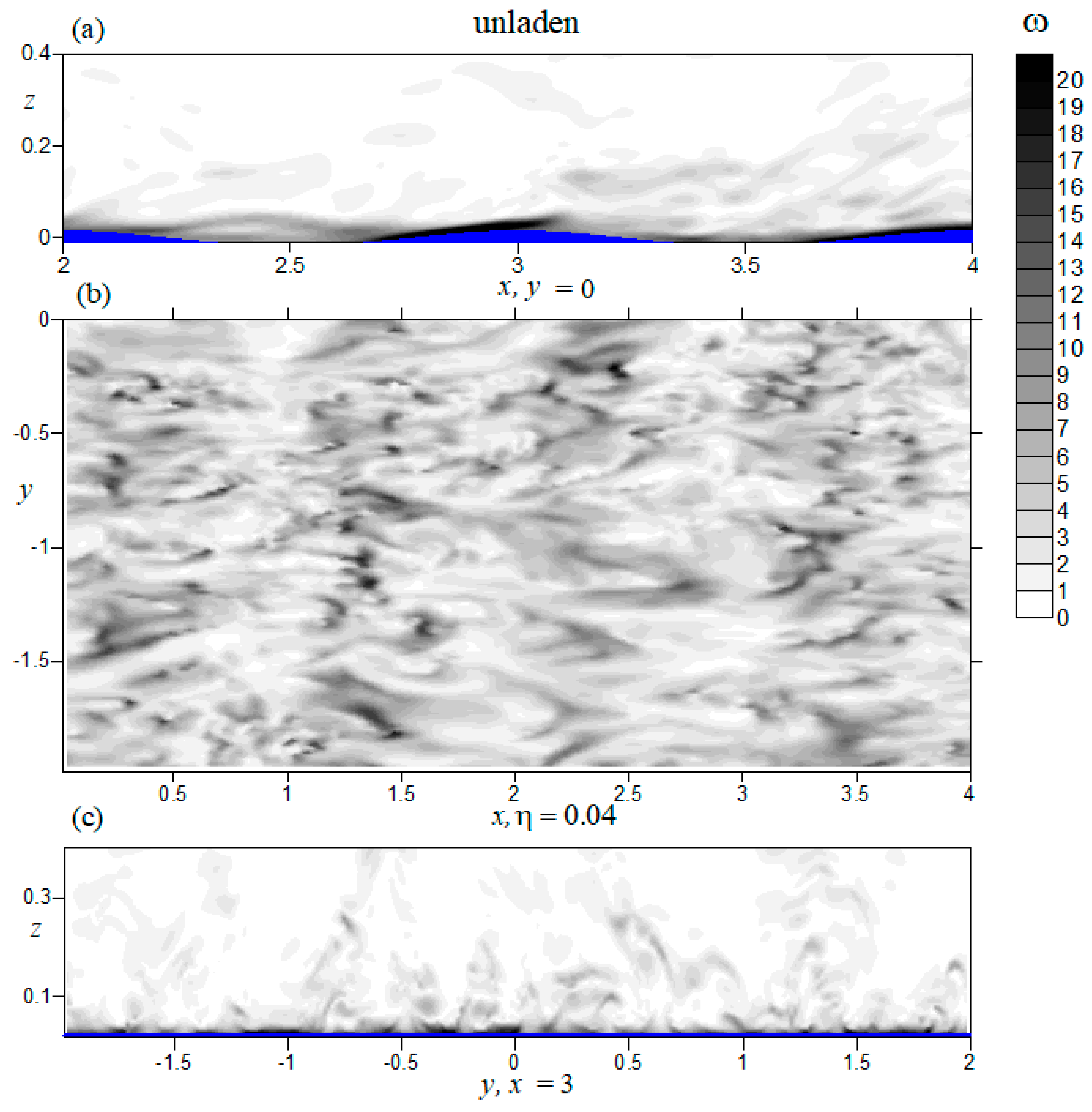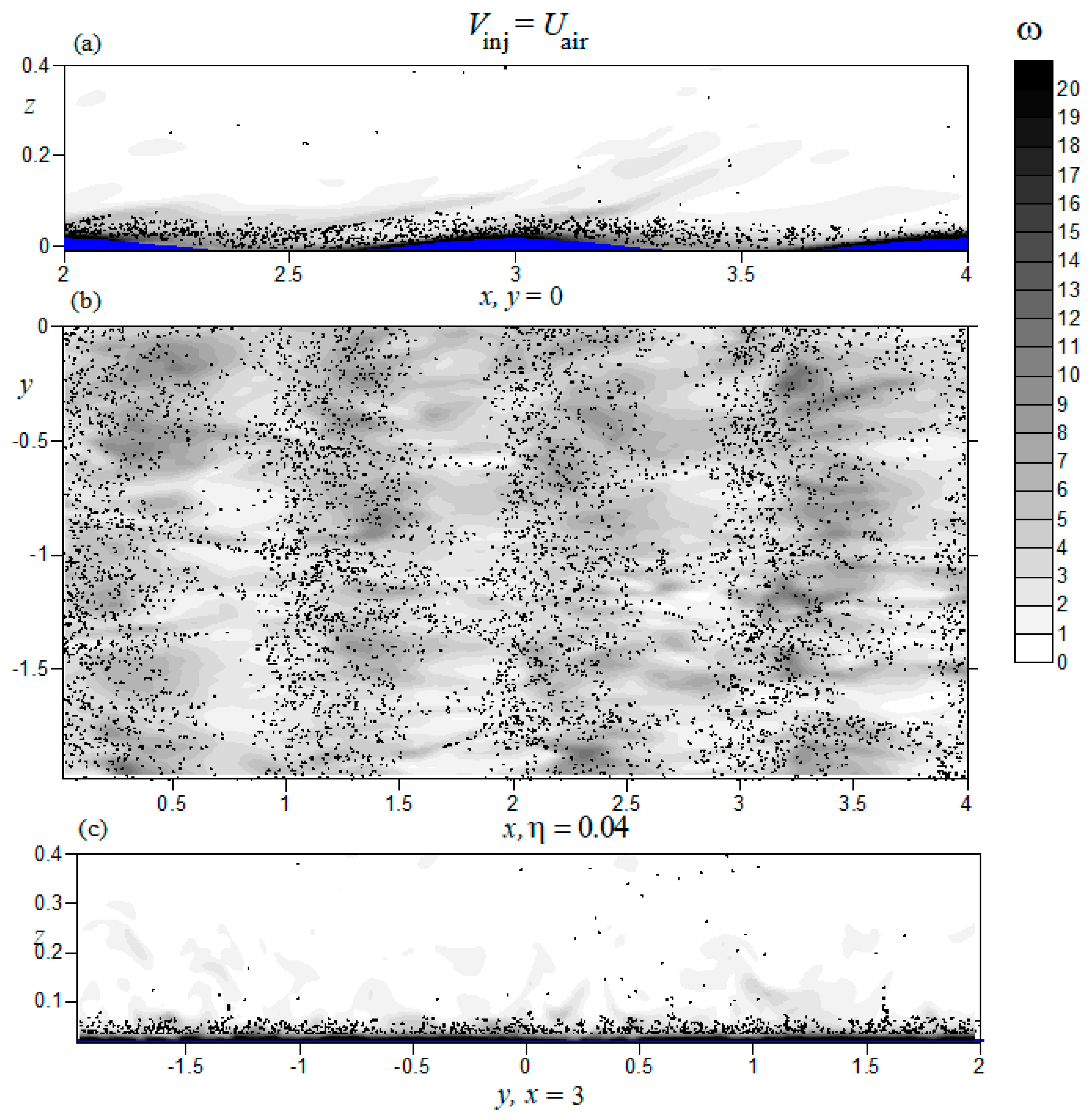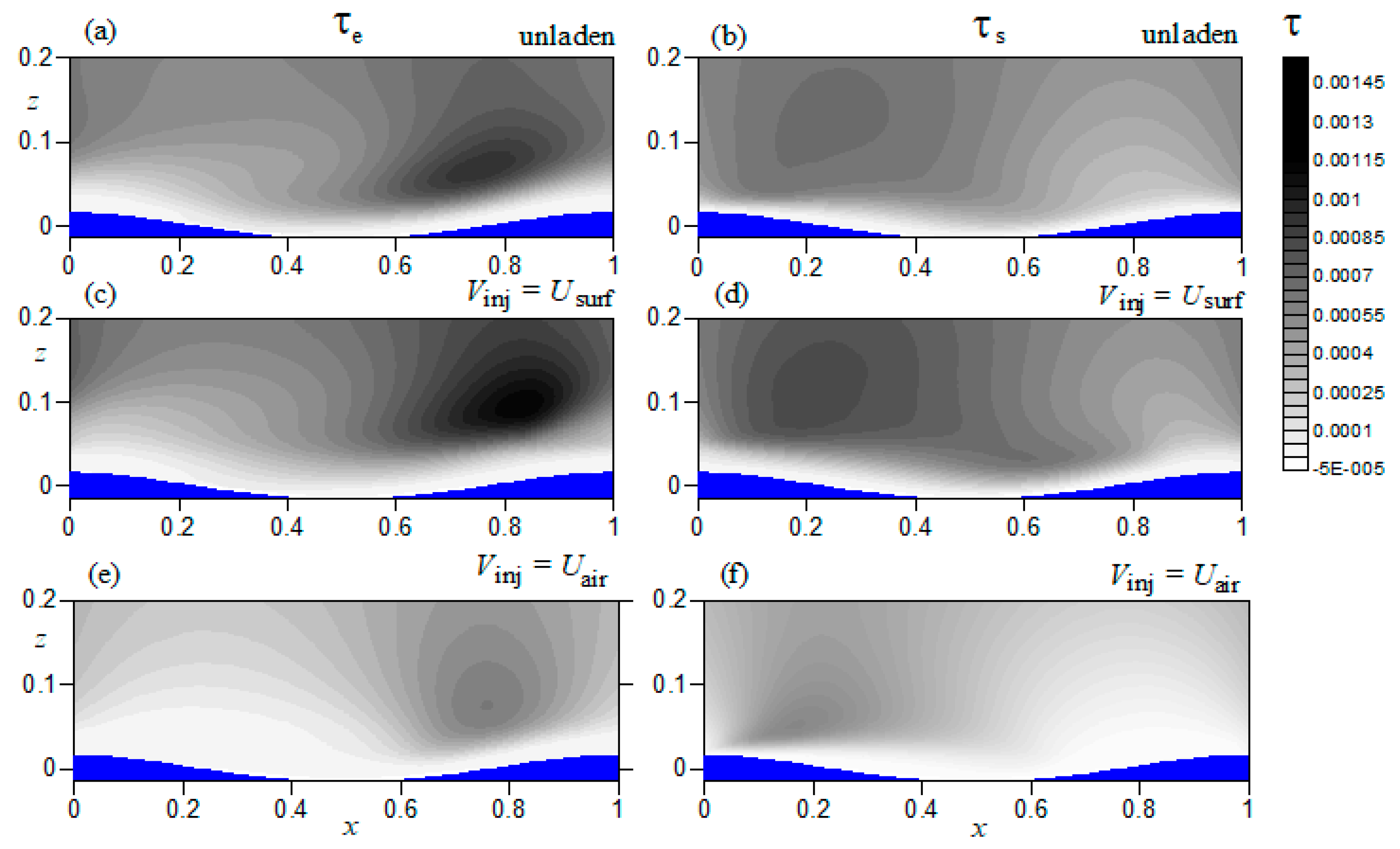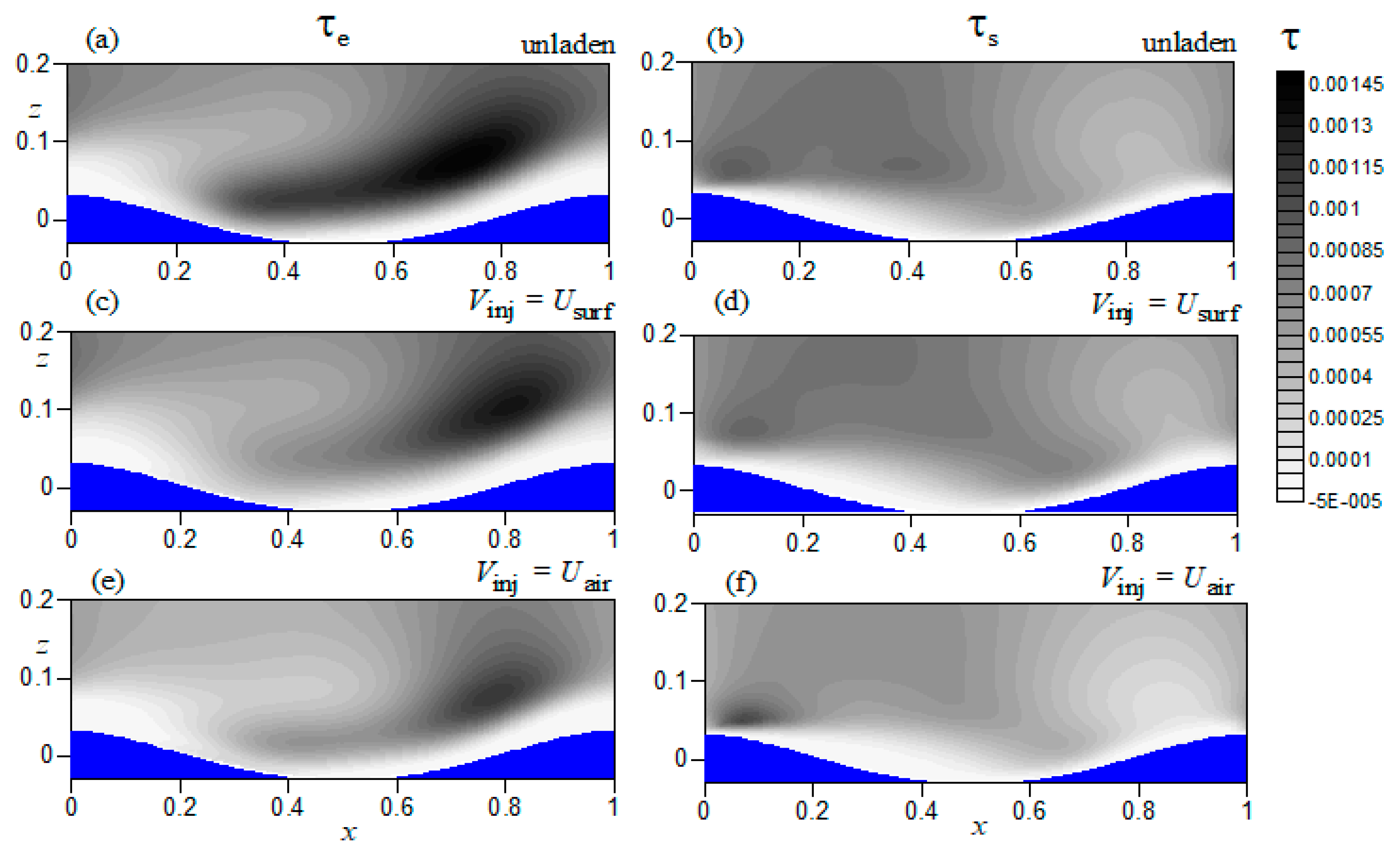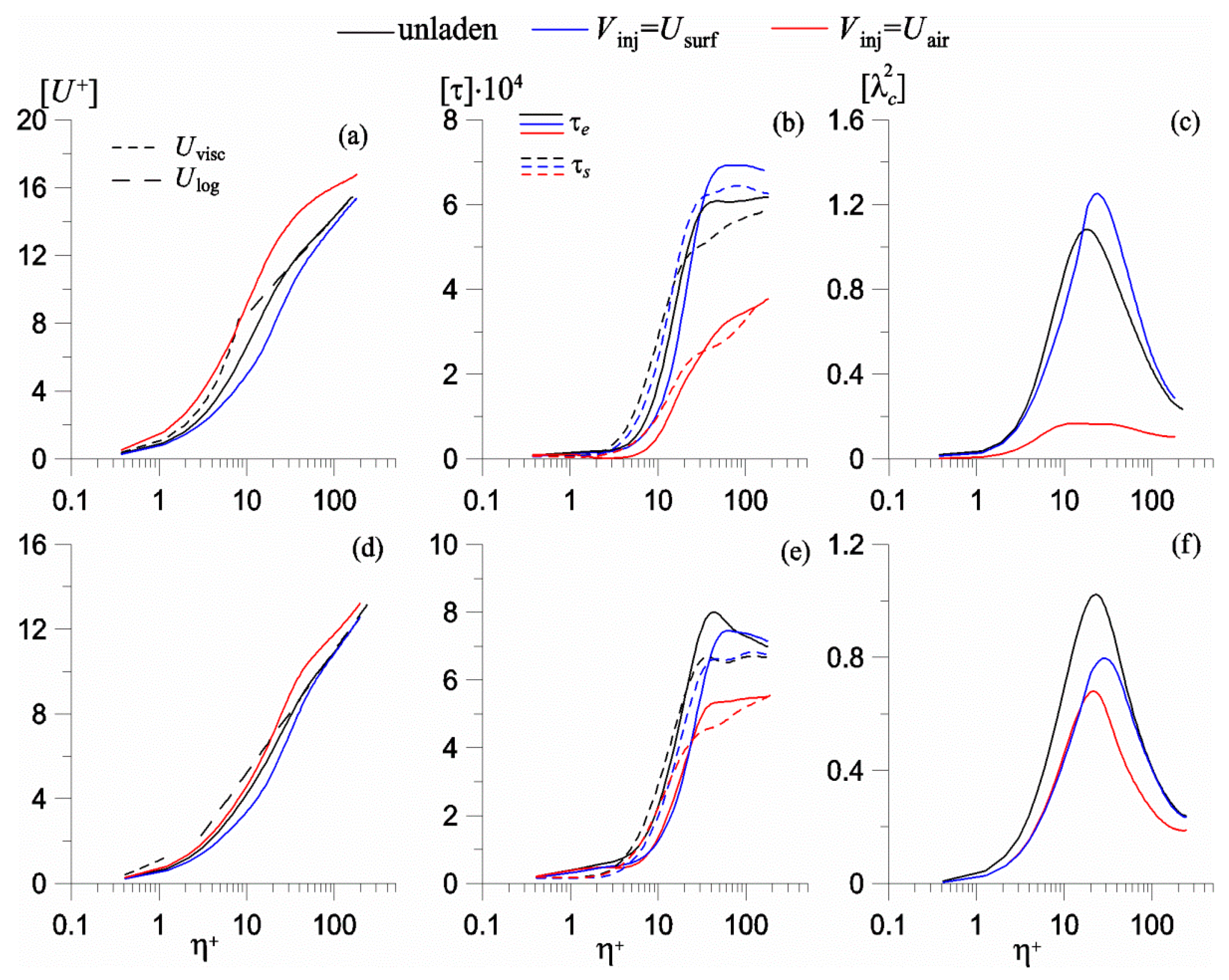1. Introduction
Large-scale prognostic models predicting bulk properties of the marine atmospheric boundary layer (MABL) are based on parameterizations of turbulent transfer fluxes of momentum, mass and heat and require detailed knowledge of small-scale exchange processes occurring in the vicinity of the air–sea interface [
1]. A turbulent boundary layer developing near the water surface is characterized by the presence of coherent vortex structures, which contribute to the air–water momentum flux and influence the surface drag [
2]. Direct measurements of droplet-mediated exchange fluxes in the vicinity of the air–water interface in field conditions and laboratory experiments are technically difficult due to the unsteadiness of the water surface in the presence of wave motions [
3]. Investigation of this flow area in the field often becomes even more complicated by air-born sea-spray droplets, which interfere with air–sea interaction and exchange fluxes [
4,
5,
6].
Direct numerical simulation represents an effective research tool and has been successfully employed in the studies of boundary layer flows in the vicinity of waved boundaries, both in droplet-free [
7,
8,
9,
10,
11] and droplet-laden cases [
12,
13]. Although the bulk airflow Reynolds numbers in these numerical experiments are typically by orders of magnitude below the values observed in natural MABL, the results provide valuable knowledge of droplet-mediated exchange fluxes, which can be further used in large-scale prognostic models [
14]. However, the impact of droplets on the carrier vortex structures has been investigated in detail only for flows over flat (solid) boundaries [
15,
16]. In these studies, a swirling strength of coherent vortices was explored by evaluating imaginary eigenvalues of the velocity gradient tensor, whereas a quadrant analysis of the velocity field was based on conditional averaging of turbulent velocity fluctuations. These studies show that, under considered conditions and injection scenarios, inertial particles reduce both swirling strength and the number of sweep and ejection events in the boundary layer as compared to the unladen flow case. These findings seem to corroborate an assumption that the impact of sea-spray droplets on MABL may be regarded as a possible reason for the drag reduction observed in hurricanes [
6,
17]. However, many aspects of the vortex structure modification, related both to the influence of water surface roughness and different possible scenarios of droplets injection, have still remained unexplored.
The objective of this study is to perform direct numerical simulation (DNS) of a turbulent, droplet-laden Couette airflow over a waved water surface. This flow can be regarded as an idealized model of the marine atmospheric boundary layer [
7]. Both the instantaneous and mean flow properties and the net impact of the dispersed droplets on the vortex structures and the momentum exchange between air turbulence and water surface are investigated. A Eulerian–Lagrangian approach is adopted where full, 3D Navier–Stokes equations for the carrier air are solved in a Eulerian frame, and the trajectories of individual droplets are simultaneously tracked in a Lagrangian frame. The impact of the droplets on the carrier airflow is modeled via a point force approximation. The droplets diameter is considered in the range of spume droplets sizes observed in the laboratory experiment [
18] (typically around 200 micron), which allows us to disregard effects related to droplets deformation. Both instantaneous and phase-averaged flow fields, the Reynolds stresses and the eigenvalues of the local air velocity gradient tensor for two surface wave slope are evaluated for two different droplet injection scenarios. The numerical method is based on an algorithm previously developed for modeling droplet-laden atmospheric boundary layers over progressive surface waves [
12] and further adopted below for evaluating the impact of the dispersed spray on MABL vortex structures and air–sea momentum transfer.
2. Governing Equations
The schematic of the problem under consideration is similar to the settings in the previous DNS study [
12] (
Figure 1). A physical domain with sizes
, with periodic side boundaries, a solid, flat upper boundary and a waved bottom boundary,
, is considered where the Cartesian coordinates are employed,
. The motion of the air is driven by the upper boundary moving with bulk velocity,
, and also by the bottom boundary in the form of a prescribed, progressive, two-dimensional (2D) stationary wave of amplitude
a, celerity
c and length
λ propagating in the positive
x-direction. The wave celerity is considered sufficiently small (
c/
U0 = 0.05,
where
is the air friction velocity), which is characteristic of “slow” waves as compared to the wind, which is typical under strong wind-forcing conditions [
7,
8]. In order to avoid coping with a strong geometric nonlinearity caused by the wavy boundary during the integration of the governing equations (to be discussed below), a mapping is introduced transforming the physical domain into a computational domain with a flat bottom boundary, and relating the Cartesian coordinates (
x,
z) to curvilinear coordinates (
) as:
where
is the wavenumber. Mapping (1) transforms the wavy boundary at
into a flat-plane boundary at
(
Figure 1). The water surface elevation,
, is defined implicitly by Equation (1) and up to the second order in
ka coincides with the Stokes wave solution [
19]:
An additional mapping is also employed for the vertical coordinate in the form:
where
, so that the grid nodes are clustered in the vicinity of the upper and bottom boundary, at
(
) and
(
), and stretched towards the middle of the domain (at
,
). The computations are preformed in a reference frame moving with the wave celerity
c where the bottom boundary is stationary. Periodic and Dirichlet conditions (to be specified below) are considered at the side and upper and bottom boundary planes, respectively.
A Eulerian–Lagrangian approach is adopted where full, 3D Navier–Stokes equations of the water motion are solved in a Eulerian frame, and the droplets are tracked simultaneously by solving their respective equations of motion in a Lagrangian frame. The Navier–Stokes equations for the carrier air are written in the dimensionless form [
1,
12,
20]:
where
,
are the air velocity components,
is the pressure, and
is a momentum source term (cf. Equation (8) below) contributed by the
n-th droplet, and
n = 1, …,
, the latter being the total, constant and number of tracked droplets. Variables in Equation (4) are normalized with velocity scale,
U0, and length scale equal to the wave length,
λ. The pressure is normalized with
where
is the air density (≈1.2 kg/m
3). The airflow Reynolds number, Re, measures the ratio of the inertial vs. viscous effects and is defined as:
where
is the air kinematic viscosity (≈1.5 × 10
−5 m
2/s). Equation (4) is supplemented by the incompressibility condition:
which implicitly defines the pressure field,
(cf. Equation (18) below).
The droplets equations of motion are written as [
21]:
In Equations (7) and (8),
are the
n-th droplet coordinate and velocity components,
is the air velocity at the droplet location,
is the material derivative along the droplet trajectory;
g is a dimensionless gravitational acceleration (to be defined below), and
is the Kronecker tensor. The correction in the viscous drag force (accounted for by factor
f) is caused by a finite Reynolds number of the droplet and defined as:
where [
21]
Dimensionless time scale
τ in the drag force on the right hand side of Equation (8) characterizes the ability of the droplet to follow variations of the surrounding air velocity and is defined as:
Notice that other forces on the droplet by the surrounding carrier air (pressure gradient, added mass, Basset and lift) are neglected as compared to the drag force in the considered case of large droplet-to-air density ratio,
, and a sufficiently small droplet diameter (
d = 200 µm) [
21,
22]. Note also that the chosen droplet diameter in DNS is smaller as compared to the viscous (“wall”) length scale (to be discussed below), and the droplet can be treated as a point particle.
The momentum source term in the right hand side of Equation (4),
, is formulated adopting a “point force” approximation [
12]:
where
is a geometrical weight-factor inversely proportional to the distance between the
n-th droplet located at
rn = (
xn,
yn,
zn) and the grid node at
r = (
x,
y,
z), and Ω
g (
r) is the volume of the considered grid cell. Thus, for each individual droplet, eight weight-factors are defined (for each of the surrounding grid nodes) and normalized, so that the sum of partial contributions distributed to these nodes exactly equals the respective total source contribution. Therefore, there is no numerically induced loss or gain of momentum in the droplet–air exchange process (cf., e.g., [
12] and references therein for a more detailed discussion).
3. Numerical Method
Since the mapping, Equation (1), is conformal, the following relations between the derivatives hold:
where the Jacobian of the transformation is:
Due to the properties in Equations (13) and (14), the derivatives over the Cartesian coordinates,
x and
z, can be related to the derivatives over curvilinear coordinates,
, as
The Laplacian operator is also rewritten as:
Equations (4) and (6) for the air velocity are discretized on a staggered grid consisting of
nodes, in the
and
coordinate directions using a second order accuracy finite difference method. The integration of Equation (4) is advanced in time by the second order accuracy Adams–Bashforth method in two stages to calculate the air velocity at each new time step,
Ui(
tk+1). First, an intermediate velocity,
, is computed using the velocity fields at the preceding time steps [
23]:
where the flux,
, is evaluated as
Further, the new pressure,
, is computed by solving its respective Poisson equation in the form
Equation (19) is solved by iterations by performing; at each iteration step (
j) the FFT in the horizontal directions and Gaussian elimination in the vertical direction. The iteration procedure stops when the condition
is satisfied. Usually, this condition is met after 3–5 iterations [
12]. The new velocity at
k + 1 time step satisfying the incompressibility condition (6) is then computed as:
At the bottom boundary,
, the Dirichlet condition for the air velocity is prescribed to be equal to the surface wave velocity [
1] (minus the wave celerity):
Periodic conditions for all the fields are prescribed at the side boundaries, and the Dirichlet condition for the air velocity is prescribed at the upper boundary,
, moving with the dimensionless bulk velocity:
The droplet equation of motion is solved by employing the Adams–Bashforth method:
In Equation (23), the surrounding air velocity at the location of each droplet is obtained via the Hermitian 4th-order accuracy interpolation procedure. The droplet coordinate equation is advanced in time by employing the Adams method as:
If a droplet leaves the computational domain via the side boundary plane, it re-enters the domain at the respective opposite side boundary with the same
z-coordinate and velocity due to periodicity in
x and
y directions. If the droplet either reaches the bottom boundary plane (the water surface,
= 0) or the upper horizontal moving plane (at
) it is re-injected into the flow. Natural and laboratory observations show that spume drops are typically injected in the vicinity of wave crests [
18,
24,
25]. In the present study, the injection model employed in [
12] is used: the droplets are injected at heights
(or
in the wall units) above the water surface and randomly distributed at upwind wave slopes in the vicinity of the wave crests. The statistics of spume droplets initial velocity distribution at present are not yet known. Therefore, two different types of injection scenario are considered. Under the first scenario, the droplet velocity at injection equals the surrounding air velocity (the case
). Under the alternative scenario, the droplet velocity at injection equals the orbital velocity of the water surface particle in an irrotational two-dimensional deep-gravity wave at given
x coordinate, Equation (21), (
). These two cases of droplet injection are modeled separately.
The airflow bulk Reynolds number in DNS, Equation (5), is set equal to Re = 15,000. The corresponding friction Reynolds number equals
, and is sufficiently large and allows a fully developed turbulent airflow. Experimental observations [
25] indicate that for spume droplets with diameters around 200
, the ratio of the terminal settling velocity,
(where
is given by Equation (11) vs. the product of the von Kármán constant and the friction velocity,
), is of the order of unity. Thus, the dimensionless gravitational acceleration,
g, is prescribed in DNS to satisfy this condition [
12].
The air velocity field is initiated as a weakly perturbed, laminar Couette flow. During an initial transient, , the source terms due to drops on the r. h. s. of Equation (4) is set to zero, and a fully developed turbulent, unladen flow regime sets in. At time , droplets are introduced into the flow, with the total (constant) number Nd = 3 × 106, and the initial uniform mass fraction is about 0.038. The droplet volume fraction remains far below 10−4 and allows neglecting hydrodynamic interactions between neighbouring droplets. The equations of motion of air and droplets, Equations (4)–(8), are solved simultaneously during the time interval with the source term “turned off”. During this transient, the droplet dynamics adjusts to the airflow dynamics. At later times, , the airflow and droplet equations of motion are solved with the source terms “turned on”. During this time interval, a statistically stationary, droplet-laden, two-way coupled flow regime is established.
Similarly, to the previous DNS studies of flows over waved surfaces [
7,
8,
9,
10,
11,
12,
13], in the statistical post-processing analysis, phase averaging, equivalent to averaging over an ensemble of turbulent fluctuations, is performed. This averaging (denoted below by angular brackets) is firstly performed over
y-coordinate and time
t, and further window averaged over
ξ—coordinate over six wave lengths as:
where
is the averaged field,
. Time averaging is preformed over
realizations in the interval
. Further, the mean vertical profile of 〈
F〉 is obtained by additional averaging along the
ξ-coordinate as:
where
Nx = 360.
The averaging procedure outlined in Equations (26) and (27) is used further to investigate the properties of the air flow vortex structure and sweep and ejections events. In order to define the swirling strength of the vorticity field, a characteristic equation of the velocity gradient tensor,
, is solved and the complex part of its complex, conjugate eigenvalues is evaluated as in [
11,
26]:
where
It is important to note that the air velocity field (
), cf. Equation (30), used for computing
does not include the wave-induced field [
11]. Field
is put to zero where
P < 0 and averaged according to Equations (26) and (27) to obtain the phase average and mean profiles,
and
.
Sweep and ejections events are characterized by conditional correlations of
x- and
z- of the velocity fluctuation components (i.e., stresses) defined as [
8]:
Vertical profiles of the stresses, and , are also evaluated according to Equation (27).
